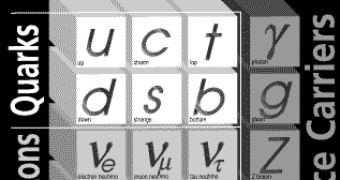Strange, but true nonetheless. The Standard Model represents a theory that incorporates all the characteristics of the material which makes up the universe we live in. There is only one problem though, out of the four elementary forces exerted between interacting matter, the Standard Model only describes three of them, the strong nuclear interaction, the weak nuclear interaction and electromagnetism; while gravity doesn't seem to find its place anywhere, which basically means that even though it describes the universe in a relatively accurate manner, the theory is incomplete.
What physicists all over the world are looking for, right now, is creating the ultimate theory that would describe all the interactions in the visible universe, the so-called 'Theory of Everything'. However, while trying to find the missing link within the Standard Model, researchers from the Universities of Edinburgh and Southampton, in collaboration with Japanese and US physicists, were only capable to confirm that the Standard Model is more precise than previously thought. So, what are they looking for then?
It is currently uncertain, albeit while measuring the interactions between elementary particles that form protons and neutrons, namely quarks, the researchers have showed that the Standard Model predicts exactly the results obtained in the computer simulations. The supercomputer assigned with the mammoth task is the fastest in the world, capable of processing a few trillion calculations per second; even so, the process took more than three full years to complete.
The result is rather worrying, especially for physicists at CERN's recently completed Large Hadron Collider, the biggest particle accelerator in the world, that hope to replace or even improve the Standard Model once experiments are set in motion. Preliminary experiments at LHC are expected to begin by the end of this year, so that in the following period the accelerator will become fully operational. The best part of the whole story is that, for the first time, physicists don't know what to expect or even if the experiment would work.
According to professor Chris Sachrajda from the University of Southampton's School of Physics and Astronomy, computer simulations can provide us with an accurate technique to determine the limits of the Standard Model; however, the next stage of the process will be carried out at the LHC particle accelerator. Until the results are verified in real life experiments, they cannot be used to construct the next model of fundamental physics.
The Standard Model has been used successfully in the past to predict the universe we live in today, but it is currently clear that these predictions are not accurate enough, thus the Standard Model cannot provide more help than it already does and must be replaced or at least improved.

 14 DAY TRIAL //
14 DAY TRIAL //